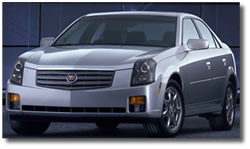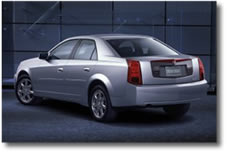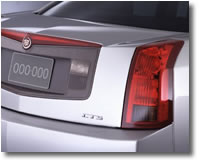|
A
Sporty Caddy
The 2003 Cadillac CTS
by
Denise
McCluggage
 Question: Will Cadillac ever again be "the Cadillac of cars?" Question: Will Cadillac ever again be "the Cadillac of cars?"
Answer:
Don't bet against it.
The journey
back to the lost throne of being the world's "standard" is
begun under the banner of "Art and Science" and leading the
way is the all-new Cadillac CTS, a so-called entry level luxury four-door
on sale after the first of the year as a 2003 model. Powered by a 3.2
liter V6 offering 220-hp, the rear-wheel drive CTS is available with
a five-speed transmission, either automatic or manual. It will be stickered
in the $30,000 to $35,000 range.
Forget
that the CTS is a Catera replacement (you remember that zig-car?) because
both the approach and the outcome are different enough to have no precedent.
The CTS is not the remake of a borrowed concept, but a totally new car
and the first to be built on GM's new world platform called Sigma.
The CTS
is aimed at drivers. The assumption: most of those who prefer performance,
agility and style to a Laz-e-Boy ride are generally younger, and thus
will Cadillac's demographics begin a desired turn toward maturing Baby
Boomers rather than their aging parents and grandparents.
Start with
the "art."
 The
look of the CTS is not a familiar sleek envelope, as smooth as used
soap. Think soap fresh out of the wrapper with edges and planes still
distinct. The CTS is blockier, more technoid in appearance than other
cars. Someone said the stylists' intent was to make the CTS look as
if it were carved from a single block of steel. Whatever. The result
is a unique blend of sharp demarcations with interim planes reminiscent
of the rocks in a Marsden Hartley landscape. The
look of the CTS is not a familiar sleek envelope, as smooth as used
soap. Think soap fresh out of the wrapper with edges and planes still
distinct. The CTS is blockier, more technoid in appearance than other
cars. Someone said the stylists' intent was to make the CTS look as
if it were carved from a single block of steel. Whatever. The result
is a unique blend of sharp demarcations with interim planes reminiscent
of the rocks in a Marsden Hartley landscape.
The CTS
with its blocks and creases could have been constructed by a paper engineer,
those clever folk who create intricate pop-up books. Imagine a page
opening and there pops up this car in its edgy intricacy. There is a
touch of magic about both the CTS and pop-ups.
For me
the handsomest aspect of the CTS is the rear three-quarter view with
its interplay of edges and spaces accented by the exclamation point
of the strong vertical taillights (said to emulate the verticality of
the Cadillac fins of yesteryear.)
Less successful
for me in the front end. The horizontals in the grille too quickly reminded
me of Venetian blind slats. Nor does the shape of the headlights delight
me, nor the bulldog-jut of the jaw line. Those impressions came as I
stood in contemplation of the car in August on the lawn at Pebble Beach
where I first encountered it. Then, oddly, in the road testing months
later that front view looked rather better when seen in a rearview mirror.
Certainly it is not just any old car.
But whatever
cavils over details come to mind the overall effect is excitement, piqued
interest and often from bystanders the mouthed "Wow!"
Like most
designs that stir such a strong positive response there are those that
dislike it intensely, too. But as Bob Lutz, now at GM after retiring
from his presidency at Chrysler, said years ago about the love-it-hate-it
redesign of the Dodge Ram pick-up: "That's the response we want.
Nobody buys their second choice".
Will it
appeal, as Cadillac hopes, to the younger crowd? My simple answer: yes!
A collection of 30 and 40-somethings I tried it on were enthusiastic,
making buyer-like noises. Said one husband to his wife: "What d'ya
think? His and hers? I get the black."
Ordinarily
I like any car best in silver but I think the champagne-like beige is
the garb of choice for the CTS. And of course black (the edges make
highlights) but only if you're fond of constant dusting.
The interior
of the CTS, happily, is a fitting companion to the exterior. A matter
not to be taken for granted with GM in past years. Too often at a motor
show I've opened the door of a handsome exterior only to be stunned
by the ugly escarpment of an instrument panel and an interior jarringly
unrelated to the outside. This dichotomy was predictable when interior
and exterior design teams worked in total separation. The CTS gives
hope that such integrity-sapping isolation is over at GM.
 Another
hope from the CTS interior: the penchant for acres of wood grain is
on the wane. Here we have the slightest wood touches, warming and not
overwhelming. They're on the steering wheel, the shift lever and the
door handle. (I'd like to see a cross-hatched metal in those places
on a sport model with 50 or so more horsepower -- my, imagine: a Caddy
inspiring slamming dreams.) Another
hope from the CTS interior: the penchant for acres of wood grain is
on the wane. Here we have the slightest wood touches, warming and not
overwhelming. They're on the steering wheel, the shift lever and the
door handle. (I'd like to see a cross-hatched metal in those places
on a sport model with 50 or so more horsepower -- my, imagine: a Caddy
inspiring slamming dreams.)
The comfortable
seats (leather of course) are easily and completely adjustable for individual
preference. In all, the interior is quite nice if not yet up to that
of an Audi, but then nothing is. And at least Cadillac had the wisdom
to emulate Audi's elegant dial adjustment on the sunroof opening. "We
copied it!" an engineer delightedly admitted. Ah, another cheering
note from Cadillac. Not-invented-here need no longer be restricting.
That a
glance at the Art, now the Science.
For driverly
appeal the CTS is rear-wheel drive and offers a manual transmission.
This combination has not been seen in a Caddy for half a century.
Furthermore
the CTS was developed to handle more challenging topography than the
controlled grades and curves of major US highways on which Cadillacs
have traditionally set sail across country and earned their reputation
for cushy comfort. Serious drivers know that such floating alienation
from the surface beneath the wheels makes for woozy discomfort, even
dangerous lack of control, on more demanding roads.
To prepare
for that more sinuous, more irregular world the CTS took basic training
on the 187 turns and twists in the mountainous old Nurburgring racing
circuit of Germany. German sports sedans have regularly trained on the
'Ring. (Like Broadway: make it here, make it anywhere.)
Cadillac
engineers let the demanding circuit be their tutor regarding the ideal
rigidity of the chassis, the suspension systems, the brakes. And thus
the CTS was toned and honed. The results are impressive.
The CTS,
unlike any Cadillac before it has become a dancing partner with the
road, not just a passing guest. To allow some of us motoring journalists
to experience this the Cadillac people chose surprisingly testing routes
on Southern California roads. (From my old racing days at the Nurburgring
I recognized similarities in some of the down-plunging twists.) On the
test routes we had rough surfaces, off-camber turns, snaking paths up
and down as well as the usual highway stretches. The CTS seemed to enjoy
the outing as much as the drivers. Cadillac
has known its survival depends on its ability to appeal to others than
its traditional but aging regulars. Yet for a transition that echoes
rather than denies the company's century-long heritage a new Caddy must
still be a Caddy, not jarringly unfamiliar to the marque's long-time
devotees. The CTS is thus a departure but not a divorce from tradition. Cadillac
has known its survival depends on its ability to appeal to others than
its traditional but aging regulars. Yet for a transition that echoes
rather than denies the company's century-long heritage a new Caddy must
still be a Caddy, not jarringly unfamiliar to the marque's long-time
devotees. The CTS is thus a departure but not a divorce from tradition.
Drivers
who long ago left American cars for the more sporting appeal of, say,
German sport sedans, will also find a bridge in the CTS. They'll welcome
the improved handling, the "autobahn" brakes. They might find
the steering not as light as an Audi, nor as sharp on turn-in as the
BMW three-series used to be (even that model feels more cottony now)
but the usual extreme understeer of American sedans is absent. Shining
all around is the serious intention to make serious drivers consider
a sporting Cadillac.
This is
only the beginning for this CTS (hotter engine) and other Cadillacs.
The Evoq and Imaj concept cars are slated for production in some form.
And surprising and gratifying has been the reception of the Escalade.
The giant SUV has received the ultimate accolade - a 'Hood nickname:
"the Slade." Caddy has been hip enough to latch on to that:
expect "Max Slade" soon.
For
more information on the 2003 Cadillac CTS, click here.
|